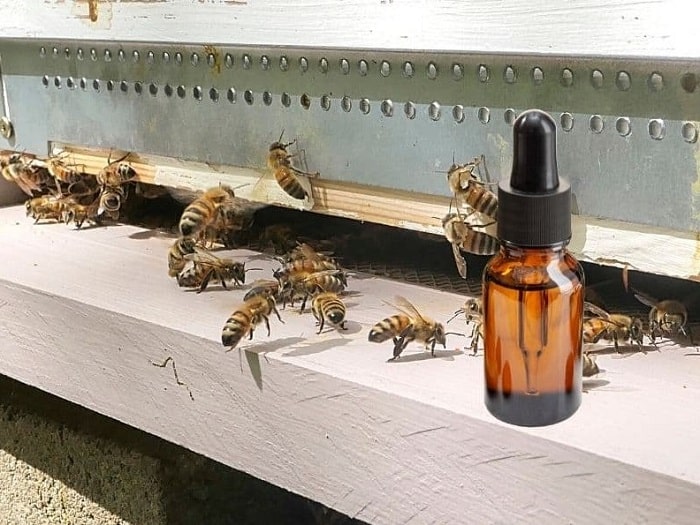Essential oils are hydrophobic liquids that have been condensed. The use of essential oils in beekeeping aids beekeepers in avoiding the use of chemicals and pollutants in their hives. At normal temperatures, the oils evaporate quickly, leaving no traces in honeybee products. However, using anything in the hive should be done with extreme caution. So, how to use essential oils for your bees?
What role do essential oils have in beekeeping?
Essential oils have numerous uses in beekeeping. The most common essential oils used in beekeeping are for attracting bees to a new beehive, suppressing Varroa mites, and preventing mold growth. When performing beehive inspections and maintenance, beekeepers also use essential oils for repelling bees. When it comes to calming bees after large changes in honeybee colony structure, lemongrass essential oil can help you get the job done quickly and easily.

What factors influence the effectiveness of essential oils?
The efficiency of essential oils for Varroa mite management is affected by the temperature and relative humidity in your beehive. They have an immediate impact on how quickly or slowly essential oils evaporate. Treatment during the summer months results in significant evaporation while necessitating additional treatments. Using essential oils to combat Varroa mites during the winter months has a lower evaporation rate and may not require you to repeat treatments as frequently.
Honey bee essential oil recipe
Spearmint and lemongrass are two essential oils that can be used to manufacture sugar syrup for honeybees. For 5 cups of water, add 15 drops of each essential oil and 2.5 pounds of sugar. Then add one eighth teaspoon of lecithin granules. Bring the water to a boil and then mix in the sugar. When all the sugar has been dissolved, the liquid is taken from the heat and the lecithin and essential oils are added.
- Stir the mixture vigorously to thoroughly combine the ingredients. Before using the essential oil mixture, allow it to cool.
- If you find that lecithin does not dissolve in your mixture, you may reduce the amount you use. Lecithin is an emulsifier that helps your essential oils and water mix well.
In the early spring and when there is no nectar, use essential oils and sugar mixes in beekeeping. It can also be used to raise swarms and packaging bees. The combo has a high feeding stimulating effect.
Essential oils for honey bee mite control
Thyme oil, Spearmint oil, and Lemongrass oil are the most commonly used oils in beekeeping. Some sites also recommend Wintergreen Oil and Tea Tree Oil.
- Thymol is found in Thyme Oil. It aids in the control of varroa mites, which are a major killer of honey bee colonies all over the world. Mites are confused by the vapors, which obstruct their breathing pores. Thymol is also antifungal and partially efficient against tracheal mites.
- Spearmint Oil functions similarly to thyme. It hides the bees’ natural fragrance (making them harder for mites to locate). It has no effect on or interferes with typical colony pheromones.
Consider fogging for Varroa mite management. It ensures that the essential oil is distributed evenly throughout the beehive. Consider including water into your essential oil blend to lessen the likelihood of your oil vapor catching fire.

>>> Read more: Top 5 Best Beekeeping Jacket for beginner
How to use essential oils on bees
A variety of approaches are used to administer essential oils to bees. They range from feeding essential oils to your honeybees to employing various technologies to disperse the essential oil throughout the beehive. The main methods of administering essential oils are:
- Using a sugar syrup infused with the essential oil
Sugar and water should be mixed together in a 1:1 ratio. You can generously add the essential oil of your choice to the syrup. However, do not put in too much oil. After that, the syrup is poured in your usual hive feeder. This approach is frequently used in conjunction with lemongrass essential oil. It also works in conjunction with tea tree oil to control tracheal mites.
- Use as an addition in sugar water instead of smoke.
Sprayed with sugar water helps distract the bees enough that they do no swarm or want to sting the beekeeper. Bees are particularly concerned with hive hygiene and their own personal hygiene. They immediately begin cleaning themselves after being sprayed with sugar water. Adding essential oil to sugar water causes bees to consume the oil as they clean themselves.
- Via winter sugar patties
These patties help your hive survive the winter. The patties are placed on your beehive frames to offer food when the bees are unable to forage outside. Sugar patties can also be used to feed bees during other seasons if the colony appears to be weak. All you need are a few drops of essential oils on the sugar patties.
- Using strips of absorbent cloth or paper
You can introduce essential oils into the hive by placing a few drops of the essential oil you wish to use to a few strips of paper or linen. The cloth or paper strips are placed inside the hive, at the entrance and between frames where honeybees pass. The bees come into contact with the paper or strips of cloth and absorb the essential oil. They next sprinkle the oil throughout the hive.

Grease Patties and Essential Oils
Although grease patties are no longer as popular as they once were, some beekeepers continue to utilize them. They were originally used to fight tracheal mites by combining crisco and sugar. Most of the year, grease patties can be used on hives. They are, however, a shambles in hot weather! As a result, the beekeepers who continue to employ them do so mostly in the winter.
When gathering honey for human consumption, they should not be used. Patties, in addition to being filthy, may attract honey bee pests.
Conclusion
Essential oils can be used in a variety of ways with honeybees. When utilizing essential oils with honeybees, however, it is critical to use the correct amounts. The dosages contained in recipes for various usage are intended to be bee-safe. Excessive use of essential oils in beekeeping may have unfavorable consequences on bees.
We do not have solid proof that essential oils can help with varroa mite problems. However, they may benefit bee health in other ways that support productive hives.
